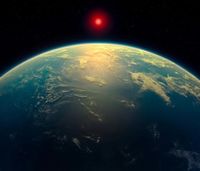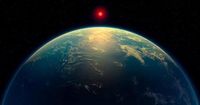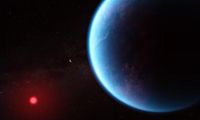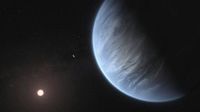A group of scientists from Cambridge studying the atmosphere of the planet K2-18b found many, but preliminary, signs of life on April 17, 2025. This discovery, made using the NASA James Webb Space Telescope (JWST), marks a significant step in the search for extraterrestrial life.
The researchers observed molecules in the atmosphere of K2-18b that are typically associated with biological activity on Earth. Specifically, they detected dimethyl sulfide (DMS) and dimethyl disulfide (DMDS), both of which are produced by marine phytoplankton and bacteria. This is the second and more promising instance of detecting chemical substances linked to life in K2-18b's atmosphere.
Professor Nikku Madhusudhan, the lead researcher, expressed cautious optimism about the findings. "This is the most compelling evidence that life may exist beyond our Solar System," he stated. He was particularly surprised by the quantity of these gases detected during a single observation period, estimating that their levels are thousands of times greater than those found on Earth.
However, the scientists emphasize that more evidence is needed to confirm the existence of life on K2-18b. Currently, their confidence in having found life is at 99.7%. By scientific standards, researchers require at least 99.99999% certainty to declare a discovery. Madhusudhan noted, "We can realistically say that we will be able to confirm this signal within one to two years." If the connection between the presence of these gases and life is validated, it could suggest that K2-18b is teeming with life.
K2-18b is located 124 light-years from Earth and is classified as a sub-Neptune, being 2.61 times larger than Earth and 8.63 times more massive. It orbits a red dwarf star, K2-18, which is approximately three billion years old. The planet's average density is lower than Earth's, yet higher than Neptune's, placing it in a unique category of celestial bodies.
Previously, in 2019, researchers had already identified significant amounts of water vapor in K2-18b's atmosphere, which is a critical factor in determining a planet's habitability. The recent findings of DMS and DMDS further enhance the prospects for potential life on this exoplanet, which is situated in the habitable zone where conditions may allow for liquid water.
Despite the exciting implications of these discoveries, the scientific community remains skeptical. Critics have raised questions about how complex life forms could survive in the extreme conditions of K2-18b, where temperatures might be much higher than the boiling point of water. The atmosphere of K2-18b is estimated to be significantly more massive than Earth's, potentially creating a strong greenhouse effect.
In 2024, an article published in The Astrophysical Journal Letters highlighted the challenges in distinguishing DMS from methane in the planet's atmosphere. Some researchers argued that the absorption bands of DMS were too weak for a definitive conclusion. However, the latest observations using JWST in the mid-infrared range have confirmed the presence of DMS with a higher degree of confidence.
Moreover, the astronomers recorded the presence of dimethyl disulfide, a related sulfur compound also produced by living organisms. The concentration of this gas in K2-18b's atmosphere was found to be thousands of times greater than on Earth, raising the possibility of a highly active biosphere.
As scientists continue to analyze the data, they acknowledge that they must rule out all alternative explanations for the presence of these gases. The research team, led by Madhusudhan, is committed to further observations to strengthen their claims. They are aware that other unknown, non-biological chemical processes could also explain the findings.
In the search for extraterrestrial life, K2-18b represents a tantalizing opportunity. The planet's unique characteristics, including its location in the habitable zone and the presence of water vapor, make it an intriguing subject for future study. The scientific community is eager to learn more about this distant world.
Looking ahead, NASA plans to launch the Habitable Worlds Observatory in the 2040s, which could provide more detailed insights into K2-18b and other similar exoplanets. However, budget cuts to astronomical programs in the U.S. pose a potential threat to this ambitious project.
As researchers delve deeper into the mysteries of K2-18b, the discovery of DMS and DMDS serves as a reminder of the vast possibilities that await in the universe. Whether or not life exists on this distant planet, the ongoing exploration continues to inspire and challenge our understanding of life's potential beyond Earth.








